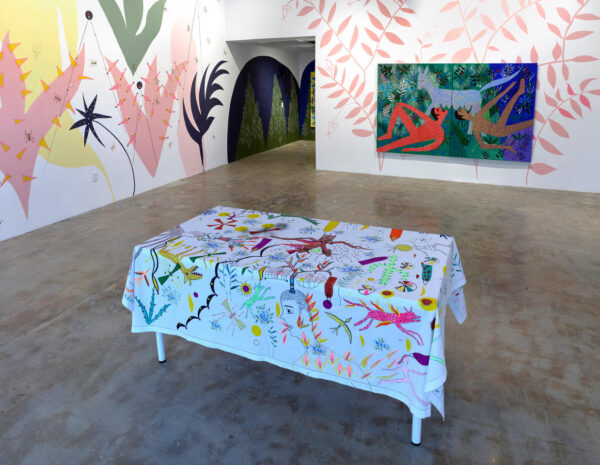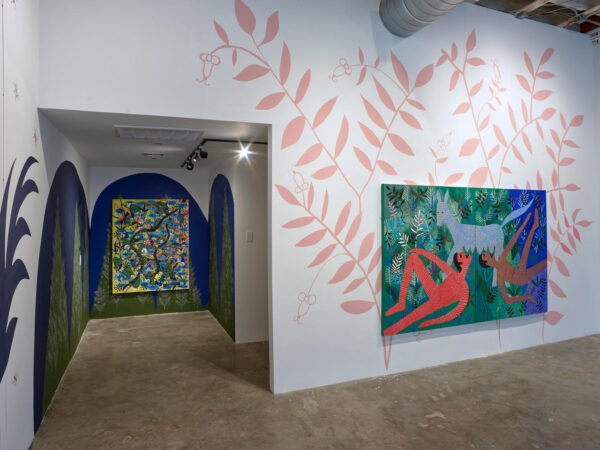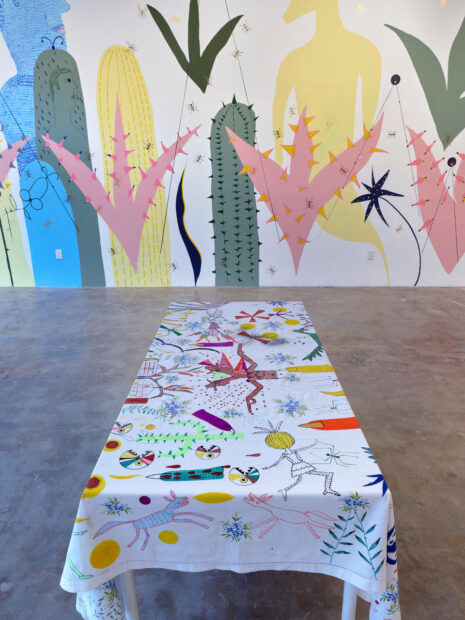If you google “magical realism” in the hope of understanding more about the contested label for a sizeable chunk of Latin American literature, you’re in for a surprise. It’s now a derogatory term, used by the U.S. media on the hawkish side (Washington Post, Foreign Policy) to criticize regimes in countries south of Mexico. No wonder that Venezuela, Gerardo Rosales’ birthplace, arguably gets the worst press in the region. But “magical realism,” or “lo fantastico,” as a recent article prefers to put it, is innocent of Nicolas Maduro or anyone else’s, transgressions. For the continent’s writers, “lo fantastico” is a way of addressing the multiple layers of indigenous, colonial, and personal histories in cases where the rational approach fails to paint an immersive picture, because not everything can be documented and procured in court.
Rosales uses “magical realism” to similar ends. In his exhibition’s centerpiece, a tablecloth bought in Venice, Italy, provides a stage for several otherworldly creatures (a double headed cowboy, a female head on seven glistening tentacles) to freely roam among the fabric’s own decorations and the artist’s inventions. Metaphors of territorial control meet ancient spirits meet the painter’s instruments in a holistic carnival of violence, beauty, and redemption.
After a brief stint in the military academy to follow a family tradition, Rosales studied art in Caracas and London before settling in Houston. Decades of contact with Western art history did not diminish his initial fundamental impulse to follow the neo-primitivist, figurative style of folk painting. His canvases and frescoes betray a deep nostalgia for the innocence of childhood and his home country’s lush landscape.
In an impressive painting that hangs in Bill Arning’s gallery’s altar space, Rosales weaves a web of vaguely recognizable biomorphic elements and includes a horde of red-teethed Pacmen in a nod to the 2-bit gaming of his youth. This fascinating work is all kinds of movement, and it looks as if it makes a noise: snakes hissing, Pacmen chewing, mosquitoes nagging endlessly in search of another host.
But the exuberant plant life is no Garden of Eden, Rosales notes, pointing to golden mosquitoes that dance around the largest wall painting in the show. Jungle might be juicy, but its liquids (and solids) endanger. One particular locality that is always on the painter’s mind is the Darien Gap, a patch of jungle that divides North and South America. A highly dangerous environment where the lives of those desperate enough to attempt a trip towards better life are regularly lost, the Darien Gap for Rosales is the metaphor of nature’s self-determined wickedness.
In a witty reversal of a canonical subject, Rosales paints a scene of two young men in the jungle, prostrate under the tits of a female coyote. The tale of two brothers left to die on the banks of Tiber is a foundational legend of the Roman Empire, which still serves as the blueprint for all imperial expansions. Rosales makes Romulus and Remus to be of the same flesh as the coyote, all three rendered in similar short brushstrokes that nod to the pointillist canvases of Paul Signac. Unlike Signac, however, whose paintings resemble a careful layering of sparkling bricks, Rosales positions the strokes so they suggest the flow of blood and other earthly energies. The story in this painting is now not about Nature saving the Heroes to lead the nation towards urban excellence and known world domination. The young men seek sustenance to persevere in the depths of the selva.
Another type of violence on display is all too human. In a suite of works on paper produced the 1990s, Rosales addresses police brutality against gay people in Venezuela. Sometimes the figures are realistic and simple, but in the most powerful work the police are a blue chimera, half-snake, half-mammal, seeking to devour a naked man who is pressed against a red car. These pieces are straightforwardly social and show the artist’s range, while putting our feet firmly on the ground.
Gerardo Rosales: Juicy Jungle is on view at Bill Arning Exhibitions through April 29.







2 comments
What a great and insightful take on a truly fantastic exhibition that no one in Houston should miss. The artist deserves more recognition. His voice is powerful. His paintings, beautiful.
Gerardo Rosales’ work always surprise me, in the best possible way. It’s constantly evolving and revamping itself, like having it’s own life, while keeping a coherence along the artist’s career.